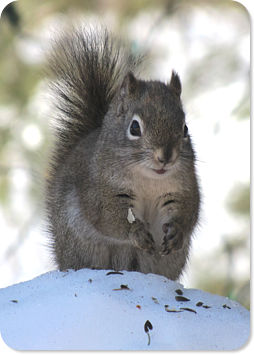 Manitoba squirrels winterize to survive.(Published in the Winnipeg Free Press, Dec. 17, 2000) I stood staring out the window the other day, warming my hands on a mug of hot soup - my lunch - griping to myself about the cold and all the holiday hubbub. "Ooh, I can't wait to get that December heating bill", I thought. Then I spied a red squirrel high in my neighbour's tree. Imagine having to live outdoors year-round without the benefit of central heating and all the other things we humans take for granted (well, most of us anyway). Nothing like a glimpse into the lives of others to get you thinking. So how do these little guys make it through a brutal Manitoba winter? The reality, of course, is that a lot of them don't. Winter is hard on all wild animals and many of the young, old and sick will die each winter. Most will survive, though, and the key is energy conservation: making their available food last all winter. Red squirrels don't hibernate. Manitoba's tree squirrels: the red squirrel, grey squirrel and northern flying squirrel, are active year round. It's their relatives, the ground squirrels, that hibernate, dropping their body temperatures and remaining inactive in an underground burrow. They don't have to deal with winter, but the red squirrel does. The biggest problem squirrels face in winter is not the cold. They grow a thicker coat of fur and construct well-insulated nests in tree cavities (or in homes or buildings). In their nest their body's normal rate of heat production, their basal metabolism, is enough to keep them warm. Their real problem is that from fall until spring no new food (to fuel that metabolism) is being produced in the environment. Red squirrels are herbivores, finding most of their food in the trees where they live: buds, leaves, fruits and seeds. Autumn marks the end of the growth season for plants and the end of food production for the squirrels. It's also harvest time! Squirrels are well known for their habits of gathering and caching food such as acorns, hazel nuts or spruce cones full of seeds. They also put on a good layer of fat, adding as much as 20% to their body weight. However, the energy that is in on their body, as fat, and in their cache of food must be made to last until spring. You might think that it would cost a small mammal more in energy on a daily basis to get through winter because of the increased cold. After all, it costs us more to heat our homes when it's colder. But the reality is the opposite, the red squirrel uses less energy, and requires less food, in winter than in summer. It's energy costs aren't like ours to heat a home, they're more like the costs of gas for our cars. Think of the squirrel's basal metabolism as the idling rate of your car's engine. Basal metabolism doesn't change much throughout the entire year. It is slightly higher in winter to provide a bit more heat for staying warm, but it's only about 10% higher. What the squirrel changes in winter is its activity level, how much "driving around" it does. It spends most of each day sleeping in its well insulated nest. It will come out for a while each day, weather permitting. In serious cold snaps or during blizzards it may not come out at all for several days. In the middle of winter, a squirrel uses about half the energy per day that it would in summer or fall when it is active and foraging for food. When a squirrel does come out in winter, it's only to grab a meal from its cache of nuts or seeds, buried close at hand. In nice weather they might come out to bask in the sun a bit and perhaps forage in the tree tops for buds, but they only come out during the warmest part of the day and they keep their activity to a minimum. Through a combination of preparation (food caching, fat storage, and nest construction) and conservation (reducing activity and avoiding bad weather), red squirrels can survive our long, cold winters. It's funny, in the animal world, it's those that get by more efficiently on less resources that thrive. Pity that isn't the case for us! Thanks for reading! Got to the: < Previous Column | What's Outdoors Front Page | Next Column >
|
||
| You can help NatureNorth produce more great articles with a secure donation through PayPal. Our Google Adsense ads pay our server costs, but that's about it. To learn more follow this link: Support NatureNorth. Thank-you! | |
Return to the: NatureNorth.com Front Page
Or pick a seasonal issue to visit:
